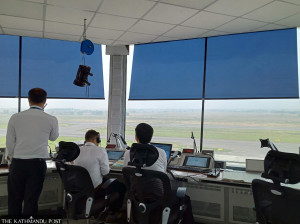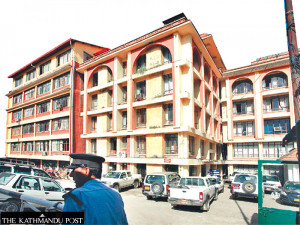Money
Nepali exports to US falling despite preferential treatment
Lack of technical assistance is part of the reason why Nepal has not been able to take advantage of the generosity, experts say.
Krishana Prasain
The United States has granted trade preferential treatment to Nepal, but traders have not been able to benefit from it because they don't know how, experts said on Thursday.
“We do not find conclusive evidence that the introduction of US trade preference for Nepal has increased exports,” said Parash Kharel, executive director of South Asia Watch of Trade, Economics and Environment (SAWTEE).
"Exports to the US are lower than what they were at their peak two decades ago," Kharel said while presenting a paper entitled "Unpacking Nepal-US Trade" at an event organised by SAWTEE.
According to experts, lack of technical assistance from the US is part of the reason why traders have not been able to take advantage of its generosity.
The US has provided Nepal with duty-free access to additional products through schemes under the Generalised System of Preferences. The scheme was introduced after the devastating earthquakes in 2015 and expires on December 31, 2025.
The US is Nepal's second largest export destination after India. The US share of Nepal's exports initially increased in the late 1990s and reached up to 27 percent. Then it started to fall.
“If we look at Nepal-US trade, we are falling behind each passing year,” said Kiran Saakha, president of the Nepal-USA Chamber of Commerce and Industry.
In 2001-02, Nepal shipped goods valued at $229.5 million to the US while imports totalled $35 million. Two decades later, in 2021-22, exports had more than halved to $107 million, but imports had increased to $196 million.
"Apparel exports to the US accounted for 80 percent of Nepal's exports during the early 2000s. This share has now shrunk to 20 percent," Saakha said.
"Following the phase-out of the Multifibre Arrangement and quota privilege, apparel exports have taken a plunge."
The US gave duty-free access to 77 items from Nepal to help revive its economy after the earthquakes of April 2015. Duty-free products accounted for 9.4 percent of the exports in 2015-16, 8.6 percent in 2016-17, 7.3 percent in 2017-18 and 6.3 percent in 2018-19.
"This shows that preferential treatment did not contribute to export growth,” Saakha said.
The Nepal Trade Preferential Programme of the US currently applies to a total of 77 tariff lines, including 56 textile, 10 footwear, 9 clothing and two fodder manufacturing products.
Among the 77 items, exports of 11 items are zero, exports of three items amounted to less than $1,000, and exports of 12 items are valued at less than $10,000. Exports of 14 items totalled less than $50,000 and exports of 26 items came to more than $50,000, according to Saakha.
“There is a provision of technical assistance in the Trade and Investment Framework Agreement (TIFA) to increase exports, but we have not been able to get it,” said Saakha.
"We have been raising the issue at every TIFA council meeting, but it has not been addressed yet. During the US Trade Representative meeting recently, the US side said that technical assistance was being provided, but we have not noticed any.” he said.
"They claim that the assistance coming from USAID is technical assistance. We are not clear about this, and if it is not providing technical assistance, we need to ask the US for it,” he said.
"Nepali garments have huge export potential but they are not in the trade preferential list," said Purushottam Ojha, former secretary of the Ministry of Industry, Commerce and Supplies.
"Nepal has also not been able to fully utilise the tariff preference in the Nepal Trade Preferential Programme. Supply-side capacity needs to be enhanced and we can also negotiate about the basic products listed in the Nepal Trade Integration Strategy," he said.
“Nepal might not be getting the facilities under the Generalised System of Preferences after graduation in 2026, and we need to lobby for the extension of the Nepal Trade Preferential Programme products and coverage of the products,” said Ojha.
"One of the biggest trade barriers for Nepal in the US is the standardisation of exported products. To address the problem, Nepal can take technical assistance from the US,” Ojha said
Nepal has also not been able to fully utilise the capacity-building programme, the expert said.
“To some extent, it is valid that technical assistant has not come from the US as expected. When requesting technical assistance and capacity building, Nepal needs to be very specific and realistic,” said Abhishek Basnyat, economic and commercial specialist at the US Embassy in Nepal.
“As the export of dog chew to the US is rising, Nepal needs to ensure the quality so that the export is not affected due to low quality,” said Basnyat.
The export of dog chew is likely to hit Rs3 billion in the last fiscal year due to surging demand in the US and Canada.
According to the Trade and Export Promotion Centre, Nepal’s exports to the US increased by 8.6 percent to Rs17.34 billion in the first 11 months of the last fiscal year.
Exports to the US swelled by 30 percent to Rs17.99 billion in the fiscal year 2021-22 from Rs13.79 billion in the previous fiscal year.
Nepal’s carpet exports in the first 11 months of the last fiscal year amounted to an all-time high of Rs10.32 billion, and the US has remained one of its largest buyers. Carpets made up 50 percent of Nepal's total exports to the US.
“It is not the private sector's job to promote Nepali goods in the international market. The government should work on promotional activities for Nepali goods in the global market,” said Saakha.




 22.33°C Kathmandu
22.33°C Kathmandu














